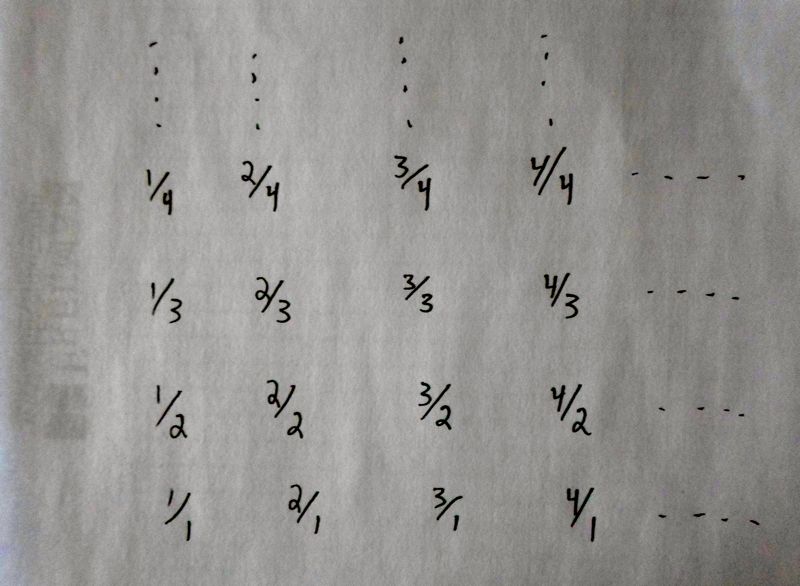Consider the set of all positive fractions: all numbers of the form \(\frac{a}{b}\), where \(a\) and \(b\) are natural numbers, but we don't let \(b=0\) (this is never allowed; dividing by zero is a no-no) or \(a=0\) (because we want positive fractions). Let's call the set of all positive fractions \(\mathbb{Q}^+\).
If we also allow for negative fractions and zero, this set of all fractions (those of the form \(\frac{a}{b}\), where \(a\) and \(b\) are any integers except \(b\) can't be zero) is called the irrational numbers, and conventionally denoted by \(\mathbb{Q}\).
Because each natural number can be written as such a fraction, for example \(5 = \frac{5}{1}\), we can think of the set of natural numbers as a subset of the set of positive fractions. So \(\mathbb{Q}^+\) is an infinite set, and it is at least as large as \(\mathbb{N}\).
Every positive fraction will appear somewhere in this array -- specifically, the fraction \(\frac{a}{b}\) is in column \(a\) and row \(b\), counting up and right. The only problem is, some fractions appear more than once! This is because, for example, \(\frac{2}{1} = \frac{4}{2}\), or \(\frac{1}{1} = \frac{2}{2} = \frac{3}{3} = \frac{4}{4}\), etc.
So we do something ad hoc, and just cross out all the duplicates in this array. This amounts to crossing out all the fractions that aren't in reduced form, i.e. aren't as simplified as possible. The picture might look like this.

Remember in the Basics section, we showed that the natural numbers \(\mathbb{N}\), which are non-negative, were the same size as the integers \(\mathbb{Z}\), which are positive or negative or zero. This involved listing out the positives and negatives in alternation. Now this same trick can be used to extend the proof we just gave, of \(|\mathbb{N}| = |\mathbb{Q}^+|\), to actually show that \(|\mathbb{N}| = |\mathbb{Q}|\).
That is, the natural numbers are the same size as the set of all fractions, the irrational numbers.
In the third module, we'll say more about the irrationals and how they defy our intuition.

